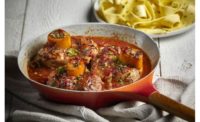Lamb’s “wow” factor
Lamb companies are using new products and education to introduce a world of new tastes to consumers.

Superior Farms introduced lamb bacon to the foodservice channel this year.

Superior Farms also introduced pre-seasoned lamb burgers to the foodservice channel.


The American population has relied on the Big Three proteins — beef, pork and chicken — for decades. Other meats get special occasions, particularly around the holiday seasons, but consumers have tended to stick with what they know for their everyday meal occasions.
That may be starting to change, thanks to a new generation of inquisitive and influential shoppers. The Millennial generation is looking for new tastes, and lamb may be the protein with the most to gain.
“Countless surveys confirm that millennial shoppers, arguably considered the most influential population segment, are looking for new cuisines, flavors and dishes with ‘wow’ factor,” says Elizabeth Dressler, vice president, marketing and business development for Mountain States Rosen, Greeley, Colo. She points to a Datassential study that showed that lamb was the fastest-growing protein showing up on menus from 2010 to 2014.
“The unique flavor, strong nutrient profile and pure virtues of our Shepherd’s Pride and Cedar Springs natural American lamb make lamb an appealing alternative for millennials and adventurous eaters,” she adds.
Lamb has long been an entrée item in fine dining restaurants, and Dressler says that in recent years, lamb has experienced sustained growth both as an appetizer and also in midscale and casual restaurant settings.
“The processors are beginning to respond to these trends and initiating training and education for foodservice sales associates and chefs regarding the use of underutilized and lower-costing cuts/items,” she says, pointing to lamb grinds, shoulder and leg cuts and using lamb as an ingredient in salads and appetizers.
“These end-meat concepts create opportunities for chefs to control their center-of-the-plate costs while serving a desired, very high-end protein,” Dressler adds.
New product development is having an impact in positioning lamb for a new generation of diners. A rack of lamb may be a costly item to order at a restaurant or buy at a grocery store, but Superior Farms of Dixon, Calif., has released several new lamb products that are a more affordable and appealing way to put lamb on the plate. One such item was a lamb bacon product for the foodservice channel. Since introducing it, the company has received fantastic feedback, says Anders Hemphill, vice president of marketing and brand strategy.
“It’s a great way for chefs to differentiate and create some new flavors,” he says. “Some are using lamb bacon on lamb burgers, some are using it crumbled over Greek salad. We even tasted a great grilled cheese sandwich with lamb bacon.”
Superior Farms introduced a line of pre-seasoned lamb burgers — Tuscan, Greek, Mushroom and Harissa — to make it easier for restaurants to introduce lamb in an easy-to-prepare fashion. The company also released a pre-cooked lamb shoulder to the foodservice market and pre-seasoned lamb leg steaks to retail. The pre-cooked shoulder eliminates hours of prep time and allows the preparer to simply warm the shoulder in hot water before using it in any application, from appetizers to sliders or tacos. The lamb steaks are vacuum sealed with a sprig of rosemary on each steak and can go straight from the shopping bag to the grill.
“Customers who have picked up these steaks at retail keep coming back for more,” Hemphill says. “We’ve seen dramatic growth in sales of these items among those retailers who are carrying them.”
Educating consumers is a key aspect of increasing lamb usage and raising the protein’s profile. Hemphill points out that consumers, who may love to eat lamb, are intimidated by the prospect of preparing it at home.
“A lack of confidence in preparing it is compounded by a price point that is higher than some other proteins,” he adds.
One effective way the company has utilized is in-store sampling, such as with the company’s pre-seasoned leg steaks.
“Giving someone a delicious bite and demonstrating how easy it is to prepare is critical,” he notes. “In January we sampled these steaks at a number of stores within a northern California grocery chain. In the four weeks following that sampling event, sales of that product across the entire chain were up 32 percent. Between January and May, sales of that product in that chain rose 400 percent.”
Mountain States Rosen’s Dressler notes that consumers are demanding that their food is produced in a way that is consistent with their own values. The company’s Shepherd’s Pride lamb is the only “Where Food Comes From” source-verified lamb in the U.S. and is being carried by more upscale retailers. Where Food Comes From Inc. is a provider of certification and verification services.
“By telling the story behind the product and putting grower information directly in the hands of the shopper, we’re able to bring traceability and transparency to the meat case,” she says.
Mountain States Rosen has also worked with popular and well-respected food, nutrition and lifestyle bloggers, many of whom were new to lamb.
“Their experimentation, shared learning, effusive testimonials and tantalizing recipes have really galvanized their legions of fans and followers,” Dressler says. “They speak earnestly about our lamb’s special qualities, affordability and nutrition.”
Many of those recipes were handheld lamb-serving suggestions, which help to dispel the notion that lamb is only for fancy, sit-down meals. Mountain States Rosen is also working on its product offerings to make lamb even more accessible to consumers.
“In addition to the forthcoming roll-out of our entirely new consumer-friendly packaging, we’ll be bringing to the market new value-added products for the convenience seeker and the adventurous, global foods tastemaker,” she says.
Looking for a reprint of this article?
From high-res PDFs to custom plaques, order your copy today!








